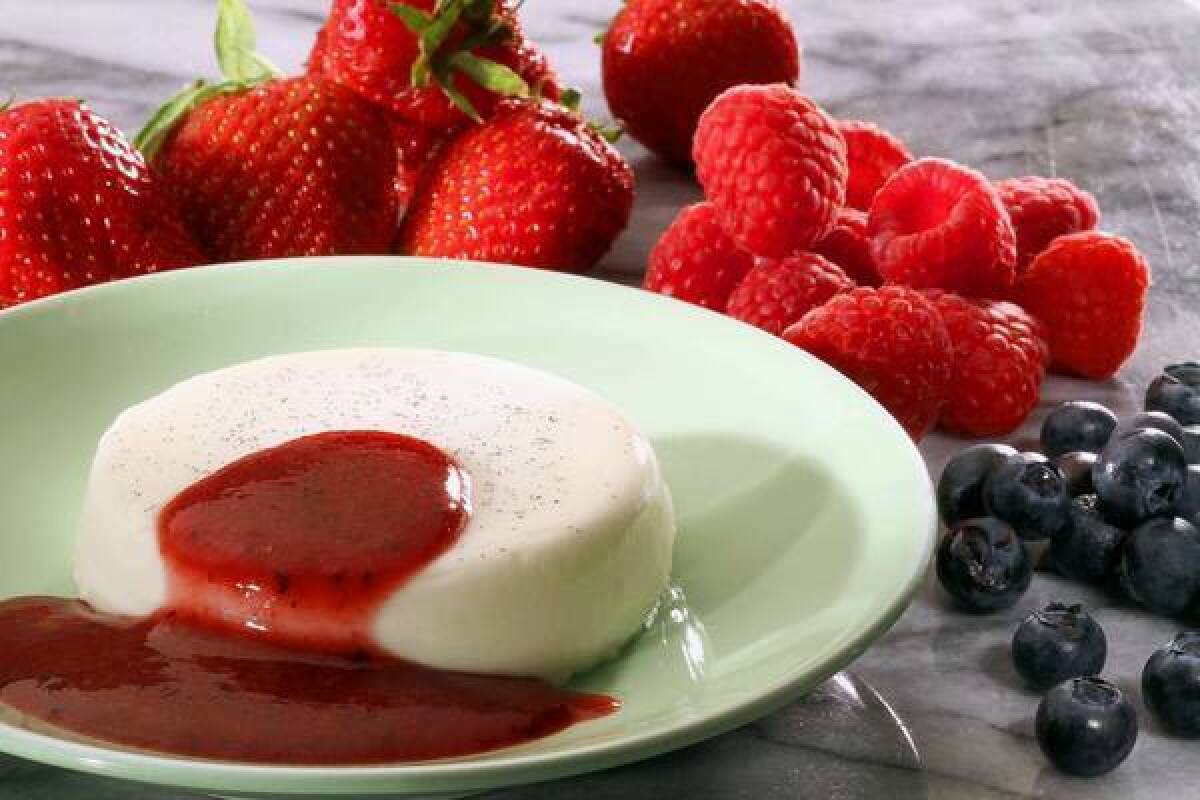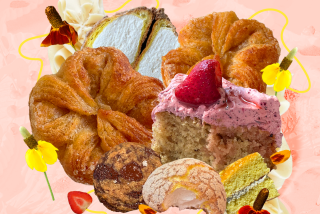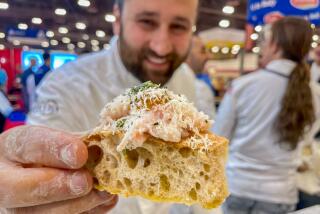The California Cook: Cracking the code of panna cotta

I’ve spent a good chunk of the last two weeks surrounded by spreadsheets, crumpled paper packets, cartons of dairy products and dirty ramekins. Josef Centeno has a lot to answer for.
A couple of weeks ago I stopped in at his Bäco Mercat restaurant downtown for a lunch that ended with one of the best panna cottas I’ve ever had. You know what I mean: Delicately sweet, it was like a dream of cream held together by faith and just a little bit of gelatin.
It struck me — how long had it been since I’d had panna cotta? A few years ago you couldn’t go anywhere without seeing it. Then just as suddenly it went away. It makes no sense. A good panna cotta is as good as dessert gets. Vowing I would never again leave my panna cotta cravings to the whims of restaurant fashion, I determined to master the dish.
How hard could that be? There’s not a lot to a panna cotta recipe. It’s just dairy, sweetened and bound with gelatin. A bit of vanilla for flavor. That’s basically it. Why, then, are some of them so wonderful and others so blah?
That’s where the spreadsheet came in. Never underestimate the lengths a food geek will go to in order to master a simple dish. I analyzed a dozen recipes for panna cotta for three main attributes: the percentage of butterfat, the amount of gelatin and the sweetness.
The jiggle
The reason for the gelatin is obvious — a perfect panna cotta should have just enough that it seems the cream is barely holding together. It quivers when you touch it. When there’s too much gelatin, the custard feels stiff and cheesy. Too little and, well, you’ve got a puddle on the plate when you unmold it.
Breaking the recipes into pieces, I found ratios of gelatin to dairy ranging from 1/2 teaspoon to almost 3 teaspoons per cup. After a day in the kitchen experimenting with various amounts, I found the best consistency was at the shaky end of the spectrum — 3/4 teaspoon per cup.
The cream
The butterfat takes a little explaining. It’s not a calorie thing, but I find too much of it leaves your mouth feeling coated and thick; the ideal panna cotta tastes light and clean.
Fortunately, analyzing butterfat doesn’t require sending it off to a lab. You can simply average the percentage of butterfat in the various dairy components. Heavy cream is 36%, half-and-half is 12% and whole milk is 3.25%. Therefore, a recipe that calls for a cup of half-and-half and 2 cups of cream will have a butterfat percentage of 28%.
I tested dairy mixes ranging from 34% to 18% (resisting the urge to completely geek out on this, I did it in 5% intervals … if you want to dial it in tighter, you’re on your own). Until you get toward the lowest end of that spectrum, the less butterfat the better — though when I tasted the 23% next to the 18%, I did find that the slightly higher fat content carried the flavor better while still tasting fresh.
The sweetness
Sweetness was relatively easy to figure. I did batches ranging from 1/4 to 1/2 cup sugar, stepping up by the tablespoon. I was looking for a panna cotta that was definitely sweetened but not sweet, if you know what I mean. Again, light and clean. Five tablespoons was perfect.
So, 21/2 cups of cream and 11/2 cups of whole milk, plus 5 tablespoons of sugar, set with 1 tablespoon of gelatin. I’d cracked the code!
What’s really remarkable, though, is that a dish so delicious can be made so quickly and easily. Bring the cream and sugar to a simmer, stir in the gelatin, whisk to room temperature and pour into ramekins. It takes about 20 minutes before chilling.
The only thing easier would be going to a restaurant. But when you buy panna cotta, you’ve got dessert for a day; when you figure out how to make it, you’ve got dessert for life.
More to Read
Eat your way across L.A.
Get our weekly Tasting Notes newsletter for reviews, news and more.
You may occasionally receive promotional content from the Los Angeles Times.











